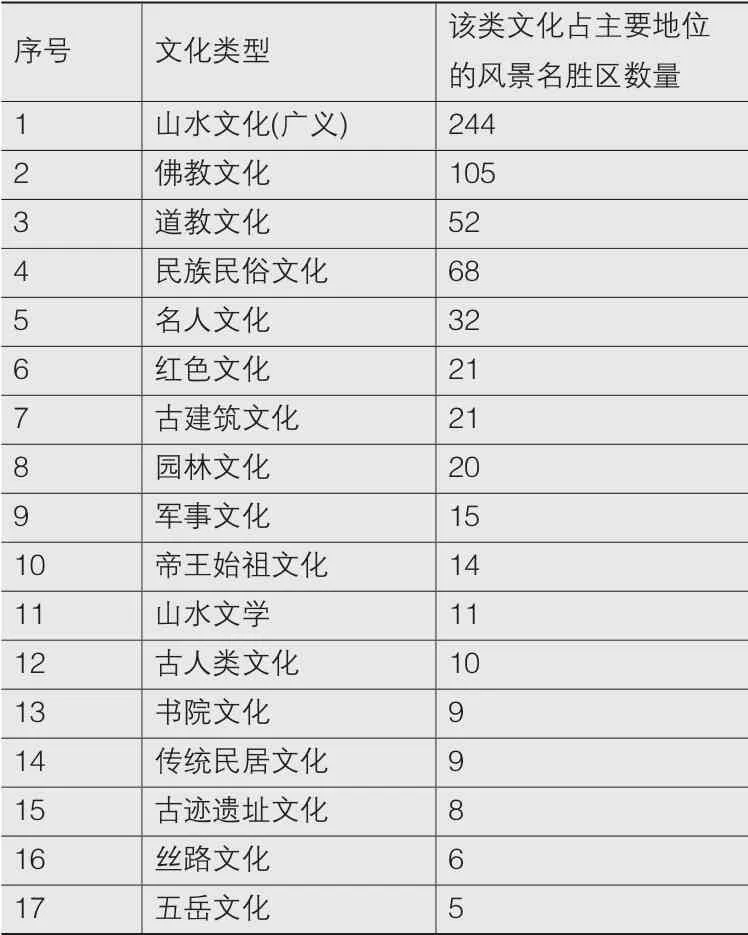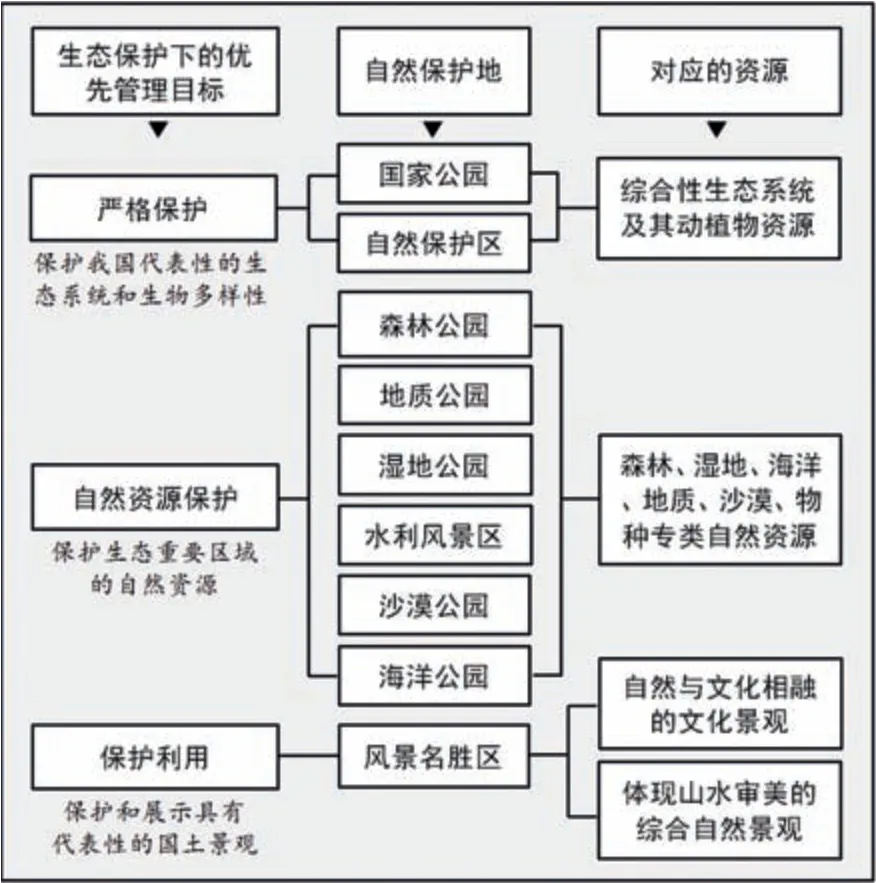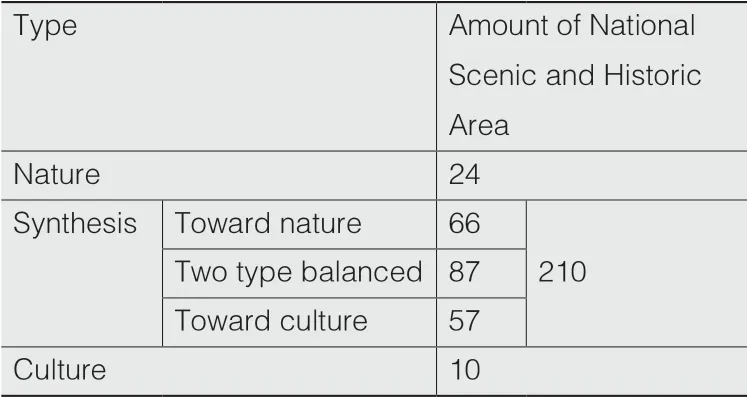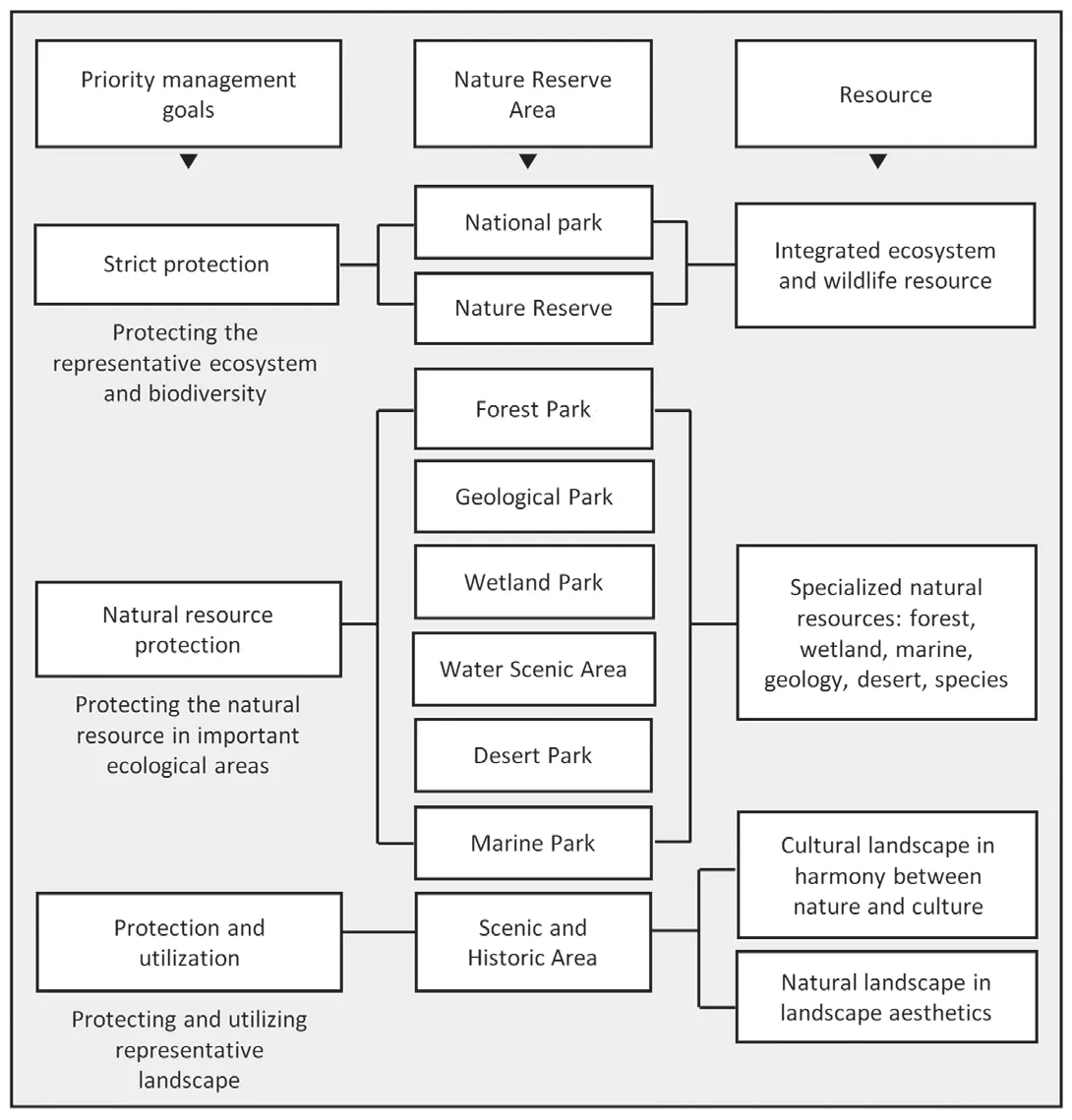从历史中走来的风景名胜区
——自然保护地体系构建下的风景名胜区定位研究
2019-04-16邓武功
邓武功
贾建中
束晨阳
王笑时
1 研究背景
《建立国家公园体制总体方案》指出,要“优化完善自然保护地体系。进一步研究自然保护区、风景名胜区等自然保护地功能定位”。党的十九大报告明确要求“建立以国家公园为主体的自然保护地体系”。改革的目的不是推翻历史,而是取其菁华、去其糟粕,不是重新设立自然保护地,而是以国家公园体制建立为契机解决现有自然保护地体系存在的矛盾问题。为此,需要根据新时代建设生态文明、美丽中国的要求,对现有自然保护地进行梳理和整合,以系统管理的理念对自然保护地进行科学分类,明确统一保护要求下的分目标管理,建立符合中国国情、具有中国特色的自然保护地体系。
要达成以上目标,首先要准确定位各类自然保护地。对于风景名胜区而言,悠久的历史、丰富的构成、多样的功能,带来了管理的复杂性,更需要尽快明确自身在自然保护地体系中的定位。
2 风景名胜区的历史基因
2.1 历史渊源
中国风景名胜区源于古代的名山大川、邑郊游憩地和社会“八景”活动[1],其形成过程与中国的文明进程密切关联。人类早期因敬畏自然而产生自然崇拜,开展了祭祀自然神的宗教和人文活动,《史记·封禅书》引《礼记·周官》的话说:“天子祭天下名山大川,五岳视三公,四渎视诸侯,诸侯祭其疆内名山大川。[2]”进入夏商周奴隶社会时期,人类更加主动地利用自然。大禹治水、修筑都江堰、开凿蜀道等人类对自然山水的改造和利用直接促成了风景名胜的形成;另一方面,人类对自然的认识也得到了升华,《逸周书》提出 “山林非时不升斤斧,以成草木之长;川泽非时不入网罟,以成鱼鳖之长”[3],自然保护、可持续发展的思想跃然纸上。管子主张“人与天调,然后天地之大美生”,老子主张“道法自然”,孔子主张“知者乐水、仁者乐山”,孟子提出“顺天者存,逆天者亡”,这些关于人与自然关系的哲学思想,是我国风景名胜区形成的文化源泉。
此后,随着人们对自然认识的不断加深,人和自然的关系越来越亲近,人们对自然不再只有恐惧、敬畏和崇拜,转而开始以审美的态度欣赏自然山水,《庄子·知北游》云:“山林欤!皋壤欤!使我欣欣然而乐欤!”儒家士大夫隐逸山水、学者远游、民间郊游之风大盛,刺激着山水美学、山水文学、山水绘画、石窟雕塑、园林文化等文化艺术的发展,形成了独具中国特色的山水文化,成为推动我国风景名胜区不断发展成熟的第一动力。“天下名山僧占多”,佛教、道教等在中国快速发展,佛教名山、道教洞天福地大多是我国著名的风景名胜区,宗教文化成为风景名胜区发展成熟的第二动力。随着中央集权封建社会的建立,社会统一、经济发展,统治者频繁的封禅祭祀及其设施修建,促使以五岳为首的中国名山风景体系形成;城市不断扩大,人民安居乐业,社会“八景”活动兴起,促进了一批城市型风景名胜区的形成;经济社会发展成为风景名胜区发展成熟的第三动力。至清代,全国性的风景名胜区已超过百个,各级地方性风景名胜区也全面发展,并形成体系[1]。
新中国成立后,随着新时代人民文化和生活需求的拓展,发展了一批具有休息疗养功能的风景名胜区如太湖、北戴河等;在山水审美的指引下,新发现了一大批自然景观优美的风景名胜区如武陵源、九寨沟、天山天池等;因工程建设而新出现了一批风景名胜区如千岛湖、柘林湖、松花湖等。
2.2 历史特征
1)审美咏叹之所。风景名胜区首先具有自然美,是美的享受场所;其自然美包括山、水、林、田、湖的各种自然形态,展现出雄、奇、险、秀、幽、奥、旷多种审美形态,自然形态与审美形态结合,构成了具有代表性和典型性的自然美景,给人以心旷神怡、飞扬激越、虔诚敬畏、轻松愉悦等心理感受,能够激发人的情感升华,李白诗曰:“飞流直下三千尺,疑是银河落九天”,对庐山瀑布美景的赞叹之情溢于言表。
2)文化传承之地。三皇五帝留下足迹、帝王先贤精心治理、佛教道教开宗立派、文人雅士诗歌咏叹、人民群众辛勤耕耘,聪明勤劳的华夏祖先在风景名胜区内孕育并衍生了极其丰富的文化。风景名胜区以物质或非物质载体的方式保存了大量文化遗产,例如包含了大量的历史文化名城名镇名村、传统村落、文物保护单位,包含了丰富多彩的民族风情,被称为“最后的母系氏族社会”的摩梭人就环泸沽湖而居流传至今。
3)天人合一之境。中国古人热衷于从自然中寻求人生真谛、宇宙真理,风景名胜区是中华民族人与自然精神往来的理想场所,是“天人合一”宇宙观的重要承载地。苏轼诗曰“横看成岭侧成峰,远近高低各不同。不识庐山真面目,只缘身在此山中”,在景物描写中充满了对人生哲理的思索。中华5 000年文明历史延绵不断,产生了无数利用自然、保护自然的生态智慧,激发了中华民族对自然的人文思辨,风景名胜区本身就是对自然的人文思辨的结果,是“人与自然和谐共生”实践的智慧结晶,也成为最能区别于西方的中国文化特征之一。

表1 世界遗产与风景名胜区的关系Tab.1 Classification of the National Scenic and Historic Area according to the typical landscape
3 风景名胜区的当代特征
3.1 代表了中国自然文化遗产价值
风景名胜区是我国壮美国土的典型性、代表性区域。泰山、黄山、武当山、井冈山、长江、黄河、太湖、桂林漓江、长城和都江堰等一系列著名的名山大川就是其中的典型代表。至2018年7月,53处世界遗产中有35处与风景名胜区有关,占我国遗产总数的66%。35处世界遗产共涉及国家级风景名胜区44处,省级风景名胜区13处。尤其是4处双遗产全部是风景名胜区;5处文化景观中有4处是风景名胜区(表1)。由此可见我国风景名胜区代表了中国自然文化遗产价值,为丰富世界遗产类型作出了重大贡献。
3.2 与中华文化息息相关
3.2.1 文化已成为风景名胜区的血脉
中国风景名胜区的发展与中华文化相伴前行,可以说是中华文化滋养了风景名胜区、成就了风景名胜区。笔者根据规划实践和公开出版物的统计,从广义的角度看,山水文化是所有风景名胜区都具有的文化类型;从狭义的角度看,现244处国家级风景名胜区中,除个别风景名胜区外,都含有各具特色的文化,据不完全统计(表2),包括佛教文化、道教文化、民族民俗文化、名人文化、红色文化、古建筑文化、园林文化、军事文化、帝王始祖文化、山水文学、古人类文化、书院文化、传统民居文化、古迹遗址文化、丝路文化、五岳文化、田园文化、长城文化、三国文化和茶文化等类型。应该说,历史、宗教、民俗、名人、诗词、书画等早已融入一草一木,使得我国的自然山水具有鲜明的人格化特征,文化已成为风景名胜区的血脉,才使得风景名胜区能够给人以精神享受。

表2 国家级风景名胜区文化类型统计Tab.2 Statistics of cultural types of National Scenic and Historic Area

表3 依据典型景观的国家级风景名胜区分类Tab.3 Classification of National Scenic and Historic Area based on typical landscape
3.2.2 人文类风景名胜区数量多
历史和文化浸润于自然环境,使得风景名胜区呈现“自然与文化交融”的资源特征,这是具有中国特色的、在世界上独一无二的文化景观。但反映到典型景观上,人文景观与自然景观之间仍存在主次之分。笔者根据典型景观资源,将全国244处国家级风景名胜区初步分为5类:自然类、偏自然类、自然人文均衡类、偏人文类和人文类(表3)。其中自然类并非指完全没有文化资源,而是相对较少或不占主要地位;后3类则是文化价值较高、人文景观较多的风景名胜区,共154处,占比达到63%。
3.3 与经济社会发展密不可分
根据2009年对187处国家级风景名胜区内的人口统计,共有人口约1 094万,人口密度约122人/km2,当时全国人口密度138人/km2,两者比值为0.88:1。将1991年统计的52处国家级风景名胜区的人口[3]与2009年的统计数据进行比较,2009年的总人口为581.93万人,增加了18.23万人,增长了3.23%;对比同期全国人口,增长了约16.7%,应该说风景名胜区的人口总量得到了有效控制。但实际上这52处风景名胜区的人口总量仍然很大,人口密度仍然比全国平均人口密度高很多,达187人/km2。而从实际了解的情况看,人口在空间分布上没有太大变化,随着经济社会发展水平的提高,其经济社会发展的压力对于风景名胜区的建设压力反而大幅增加。
从现今244处国家级风景名胜区在全国的分布看,与揭示我国经济社会发展分界线的胡焕庸线完全一致,在胡焕庸线以东我国经济社会发展水平较高的地区,共有224处国家级风景名胜区,占比达91.8%。
3.4 与城市关联紧密
我国风景名胜区的起源之一是古代的邑郊游憩地,如杭州西湖、武汉东湖、岳麓山等最为典型。随着城市的发展,原来的邑郊游憩地逐渐纳入城市建设区,一大批风景名胜区成为新的邑郊游憩地。这些风景名胜区深受城市的影响,它们在空间上靠近城市;在文化上与城市交融,受城市园林文化、节日文化、城市休闲文化等影响很大;在功能上为城市居民提供游览、科普、休闲等多重服务。
根据风景名胜区与城市关系,在244处国家级风景名胜区中,与城市关系密切甚至位于城市建成区内的风景名胜区有81处(表4),占比达33.2%。
3.5 旅游职能突出
风景名胜区的美丽风景自古深受人民的喜爱,从官方到民间对风景名胜区的游览、欣赏与营建活动持续不断。因而,自我国1982年公布第一批国家级风景名胜区,正式建立风景名胜区制度以来,在资源保护的基础上,将风景名胜区的美景进行充分的展示利用是风景名胜区的优先管理目标,因而旅游也就成为其主要职能之一。2016年全国国家级风景名胜区游客量8.85亿人次,约占当年全国旅游人数的20%,对旅游发展贡献巨大。
尤其是一部分风景名胜区因其资源的特殊性,旅游功能尤其突出,如三亚热带海滨、秦皇岛北戴河等风景名胜区,因其优良的气候条件、优质的海滨沙滩资源,成为我国为数不多的海滨度假胜地,休闲度假就成为其主体功能;还有一部分风景名胜区因位于城区内,如蜀岗瘦西湖、惠州西湖、广州白云山等,其为市民服务的休闲娱乐功能尤其突出。
4 风景名胜区新时代的重要作用
风景名胜区是建设美丽中国的绝佳载体。天人合一的哲学思想,国家代表性的壮美风景,保护与利用的中庸之道,使风景名胜区成为践行“建设美丽中国”“坚持人与自然和谐共生”“绿水青山就是金山银山”等重要思想的绝佳载体。
风景名胜区是坚定文化自信的重要源泉。文化是一个国家、一个民族的灵魂,没有高度的文化自信,就没有中华民族的伟大复兴。风景名胜区整体保护了传统文化所处的自然与人文环境,使之能够延绵不断地传承至今,使传统文化成为活的可传承的文化,是对中华民族文化传承的重要贡献[4]。
风景名胜区是实现乡村振兴和精准扶贫的重要手段。国家级风景名胜区是我国最重要的旅游目的地,对于推动旅游产业发展具有领头羊作用,也是促进地方经济繁荣的重要力量。尤其在当前转变经济发展方式、实施乡村振兴战略、打赢脱贫攻坚战的关键时刻,风景名胜区的旅游职能发挥了巨大作用。通过旅游收入反哺居民、促进居民就业等多种方式,很多风景名胜区的所在地区成为乡村振兴、绿色发展、脱贫致富的典范[4]。
风景名胜区是再造秀美山川的重要力量。未来风景名胜区将继承自然与文化交融的传统,传承与创新并举,在绿水青山之上融入新时代文化需求,塑造新时代风景,满足人民群众欣赏、游憩、娱乐等精神文化需求的同时,为后世流传新的经典。
5 新时代风景名胜区的自身定位
汲取历史的营养,适应新时代生态文明、美丽中国的要求,以创造“更优美的环境、更丰富的精神文化生活”为目标,风景名胜区的自身定位清晰可见。
5.1 资源定位
风景名胜区作为文化传承之地和天人合一之境,“自然与文化交融”的文化景观是风景名胜区区别于其他自然保护地的最突出的资源特征。凡是具有此类资源特征的地区都应纳入风景名胜区进行管理。
风景名胜区作为审美咏叹之所,对于能够展现壮美国土,激发中华民族特有的山水审美和山水情怀,给人以精神享受和教育启迪的优美自然景观,也应纳入风景名胜区进行管理。

表4 与城市关系紧密的国家级风景名胜区Tab.4 National Scenic and Historic Area closely connected with cities
5.2 功能定位
风景名胜资源是自然与祖先馈赠的美景,我们当代人要把它保护好、利用好,并永续传承给子孙后代,其功能可简要概括为3个方面:保护资源、传承文化、展示利用。
1)保护资源。首要保护的就是风景名胜区“自然与文化交融”的文化景观,包括自然景观、人文景观本身及其所处的周边环境。另一方面,风景名胜区的本底是自然生态环境,是全国生态系统的重要组成部分,保护自然生态环境是风景名胜区的基础功能。
2)传承文化。风景名胜区见证了中华民族几千年的发展历史,融合了众多的传统文化,孕育了独树一帜的山水文化,保存了大量珍贵的文化遗存,在一些少数民族地区更是具有“活化石”“活标本”的特点。风景名胜区已成为展示和感受中国文化最直接、最生动的窗口。传承文化是风景名胜区的历史责任和应有之义。
3)展示利用。这一功能范围比较宽泛,可以是访胜猎奇、饱览美景的游览欣赏,可以是增长学识、陶冶情操、回归自然的精神享受,可以是科研、科普的教育活动,也可以开展娱乐休闲活动,还可以发展旅游经济。
5.3 保护定位
天人合一思想指导下的风景名胜区为世界创造了一种保护地范式,是历史文化底蕴深厚的中华民族的智慧之光。相较于国家公园、自然保护区等保护地相对单纯的自然生态保护目标,保护风景名胜区的核心在于人与自然和谐共生、保护与利用相协调,而不是单纯的保护。国务院《风景名胜区条例》确定的“科学规划、统一管理、严格保护、永续利用”十六字原则是经过几十年实践检验的理论总结,是风景名胜区仍应遵循的基本原则。
5.4 总体定位
综上,风景名胜区是最具中国特色的自然保护地,风景名胜资源是具有国家代表性和典型性的自然文化遗产资源。风景名胜区是深刻体现美丽中国、文化自信的“活态”载体,它为实现人与自然和谐共生提供了中国智慧和中国方案。
6 风景名胜区在自然保护地体系中的定位
我国自然保护地的主要类型,除正在试点的国家公园外,还包括自然保护区、风景名胜区、地质公园、森林公园、湿地公园、沙漠公园、海洋公园和水利风景区等。今后自然保护地统一到一个部门管理,必须以“全国一盘棋”的思路,设定清晰的目标管理框架。根据国家公园体制改革的要求和现有自然保护地的设立管理情况,在生态保护的核心管理目标下,可以按照严格保护、自然资源保护和保护利用三大优先管理目标来区分各类自然保护地(图1)。

图1 生态保护下的优先管理目标与自然保护地的关系(作者绘)Fig.1 Relationship between prioritized management goals and Nature Reserve Area
鉴于风景名胜区的定位与资源特色,其应以保护利用作为优先管理目标,在保护自然生态环境和自然文化景观资源的基础上,充分展示自然文化美景;在中国自然保护地体系分类中,应将风景名胜区作为特殊类型予以高度重视,充分体现风景名胜区所代表的中国特色,建立起以国家公园为主体、自然保护区为基础、风景名胜区为特色、各类自然公园为补充的自然保护地体系[5]。
7 展望
建设美丽强国、实现生态文明是新时代的宏伟目标,构建以国家公园为主体的自然保护地体系是新时代的改革要求。风景名胜区因其悠久的历史和深厚的文化背景,以传承历史、面向未来的眼光明确其定位,能够使我国建立的自然保护地体系突出中国特色、传承历史智慧。目前的风景名胜区还存在着与其他自然保护地交叉重叠、功能错位的矛盾问题,今后需要根据风景名胜区的定位进行整合优化,尽早构建形成分类合理、管理有效的自然保护地体系,并使风景名胜区成为科学保护和合理利用自然文化资源的典型范例,在增强我国文化自信、探索世界人与自然和谐共生等方面进一步为世界作出贡献。
Scenic and Historic Area out of History—Study on the Positioning of Scenic and Historic Area Based on the Nature Reserve Area System
DENG Wugong
JIA Jianzhong
SHU Chenyang
WANG Xiaoshi
Scenic and Historic Area is one of the most complicated nature reserve area with long history in China.In the process of building the nature reserve area system in China,it is necessary to position accurately so as to realize the sustainable inheritance of Scenic and Historic Area to future generations.
1 The Historical Genes of Scenic andHistoric Area
Scenic and Historic Area in China originated from the ancient famous mountains and the great rivers,the suburban recreational area,and the "Eight Sceneries" community activities.Its formation process is closely associated with Chinese civilization process.With the economic and social development,humans worshipping nature is turning to utilizing,appreciating and protecting nature in the long-term interaction between human and nature.Under the guidance of the philosophical theory "unity of heaven and human",the natural landscape is blended with the Chinese unique landscape culture and religious culture,and gradually formed the Scenic and Historic Area.That makes Scenic and Historic Area the place of aesthetic chanting,the place of cultural inheritance and the place of harmony between human and nature,and revealing the distinct Chinese characteristics.
2 The Contemporary Characteristic of Scenic and Historic Area
2.1 Representing the value of Chinese natural and cultural heritage
Scenic and Historic Area is the typicality and representation for the glorious homeland.Until July 2018,there are 35 places related to Scenic and Historic Area out of 53 World Heritages totally in China,as 66 percent of the total number.In particular,all the four World Nature and Culture Heritages are Scenic and Historic Areas,and four of five the World Cultural Landscapes are the Scenic and Historic Areas.It made a great contribution for enriching World Heritage types.
2.2 Closely related with Chinese culture
Chinese culture nourished and achieved Scenic and Historic Area.According to the statistics,there are 244 National Scenic and Historic Areas,and all of them contain unique cultures except few National Scenic and Historic Areas.Culture is related with Scenic and Historic Area including history,religion,folk-custom,celebrity,poetry,calligraphy and painting,which made the natural landscape have distinct personalized characteristics.Culture had become the blood of Scenic and Historic Area that made Scenic and Historic Area presenting the characteristics of "natural and cultural blending".It is unique cultural landscape with Chinese characteristics in the world.Throughout the country,there are 244 National Scenic and Historic Area divided into five classes (tab.1).The last three classes are Scenic and Historic Areas with high cultural value and more cultural landscape,154 in total,accounting for 63 percent.
2.3 Closely related with economic and social development
In 2009,there are totally 10.94 million people in the 187 National Scenic and Historic Areas.The population density was about 122 people per square kilometer,which is closed to the average population density in the country that was 138 people per square kilometer.From the geographical distribution,91.8 percent of National Scenic and Historic Areas are located in the east of Hu Line that the economic and social development level is higher.
2.4 Closely related with city
33.2 percent of National Scenic and Historic Areas are closely related with city or even located in the urban built-up area.With the influences by city,Scenic and Historic Areas are close to the city on the space,blend with urban culture,and besides,provide multiple services on the function for citizens,such as sightseeing,popularization of science and leisure.

Tab.1 Classification of the National Scenic and Historic Area according to the typical landscape
2.5 Outstanding of tourism function
National Scenic and Historic Area tourist amount is 885 million in 2016,about 20 percent of the tourist amount on nationwide,which made great contribution on the tourism economy.Especially in some Scenic and Historic Areas such as Sanya tropical seaside,the tourism function is particularly prominent based on the special resources.
3 Important Role of Scenic and Historic Area in the New Era
Based on the philosophy of the unity of heaven and human,the beauty of the country representative landscape,the continuity of traditional culture,and the golden mean of protection and use,Scenic and Historic Area is an excellent carrier for building a beautiful China,an important source for firm cultural self-confidence,an important means for realizing rural revitalization and targeting poverty alleviation,and an important force for rebuilding beautiful mountains and rivers.
4 Self-positioning of Scenic and Historic Area in the New Era
4.1 Resources positioning
All the areas that have the "natural and cultural blending" in resources characteristic should be included in management as Scenic and Historic Area.The natural landscape showing the glorious homeland,inspiring the Chinese unique landscape aesthetics and feelings,providing spiritual enjoyment and educational enlightenment,should be included in management as Scenic and Historic Area as well.
4.2 Function positioning
The functions of Scenic and Historic Area could be briefly summarized as three aspects: 1)protecting resources: primary protection is the cultural landscape of "natural and cultural blending",and the second is the natural ecological environment.2)inheriting culture,that is,preserving traditional culture over thousands of years and developing contemporary culture in Scenic and Historic Area.3)exhibiting and utilizing,including sightseeing,spiritual enjoyment,scientific education,recreational activities,and development of tourism economy,etc.
4.3 Protection positioning
Under the "unity of heaven and human",Scenic and Historic Area creates a model of protected area for the world.Its core is to realize harmony between human and nature,as well as protecting and utilizing,rather than a simple ecological protection.
4.4 Overall positioning
In conclusion,Scenic and Historic Area is the most Chinese characteristic type in natural protected area that the scenic and historic resources have national representative and typicality in natural and cultural heritage resources.Scenic and Historic Area is a living carrier reflecting beautiful China and cultural confidence.It provides a Chinese solution with Chinese wisdom for harmony between human and nature.
5 Positioning of Scenic and Historic Area in Nature Reserve Area System
According to the reform requirement for the National Park System and the situation of established management for the existing nature reserve area,distinguishing all kinds of nature reserve area is based on the three prioritized management goals that are the strict protection,natural resource protection,and protection and utilization under ecological protection (fig.1).

Fig.1 Relationship between prioritized management goals and Nature Reserve Area
Scenic and Historic Area should take protection and utilization as the prioritized management goal.In Chinese classification of nature reserve area system,Scenic and Historic Area should be highly regarded as a special type to fully reflect the Chinese characteristics.A nature reserve area system should be built in China that takes National Park as the main body,Nature Reserve as the foundation,Scenic and Historic Area as the characteristics,and all kinds of natural parks as the supplement.
(Editor/JIN Hua)
